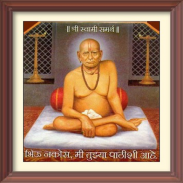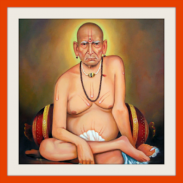




Shri Swami Mala Mantra श्री स्वामी माला मंत्र

Descripción de Shri Swami Mala Mantra श्री स्वामी माला मंत्र
Shri Swami Samarth Mantras | OFFLINE | HD Audio | Repeat | FREE | HD God image
Swāmi Samarth Mahāraj more commonly Shri Swami Samarth Maharaj (also known as Akkalkot Swāmi Mahāraj) of Akkalkot (left the physical body in 1878). He was also lovingly referred to as Swami Samartha or Akkalkot Maharaj by his devotees.[3][4] was an Indian Guru of the Dattatreya tradition (sampradaya), widely respected in indian states of Maharashtra,[5] as well as in Karnataka and Andhra Pradesh with Shripad Shri Vallabha and Narasimha Saraswati. His existence in physical form is dated in the nineteenth century AD.
Shri Swami Samarth traveled all over the country and eventually set his abode at Akkalkot village in Maharashtra, India. Maharaj first appeared at Akkalkot on a Wednesday around the September–October period in the year 1856 AD near Khandoba Mandir. He stayed in Akkalkot for close to twenty-two years. His parentage & native place details remain obscure to this day. Once when a devotee posed him a question about his life Shri Swami Samarth indicated that he is the origin of the Banyan tree (Vata- Vriksha). On another occasion Swami said that his name was Nrusimha Bhan and that he was from Kardalivan near Srisailam
The description of Shri Swami Samarth's appearance has been based on the vivid descriptions given by close devotees. Though he was seen at an advanced age, his skin was not wrinkled. He was very tall and his hands were long, extending down to his knees. His belly was protruding and he had broad shoulders. His complexion was fair and pinkish. He had big ears with thin and long ear-lobes which shook with the slightest movement of his body. He had long feet. He adorned a sacred mark (thilakam) on his forehead. He always wore a codpiece (kaupina). He had a fine set of teeth and a big and deep navel. He always wore a tulasi-rosary (which is very different from rudraksha) and a crystal (sphatika). He had ear-rings inset with gems.
* The Siddha Mantra of Shri Swami Samarth is: SHRI SWAMI SAMARTH (Marathi: श्री स्वामी समर्थ )
* The biography of Shrivallabh is in the Shripada Shrivallabha Charitramrut
* The biography of Nrusimha Saraswati is in the Gurucharitra.
* The biography of Shri Swami Samarth is in the Guruleelamrut.
In the month of Chaitra (April–May) in 1878, the thirteenth day of the dark-half of the lunar month. Swami Maharaj lived mainly at the residence of his disciple Cholappa, where his shrine is now located.
As such Swami can not undergo death like ordinary people[citation needed]. It is believed that, he is in existence before beginning of the universe and will exist after destruction of the universe. Swami can not disappear suddenly in front of people and he performed a rite known as Samadhi, which has death like effect but not an actual death. Swami is for perpetuity.
Anant Koti Brahmand Dayak Gajanan अनंत कोटि ब्रह्माण्ड दायक गजानन
Swaminche Sahasranam स्वामींचे सहस्रनाम
Shri Swami Samarth Taarak Mantra श्री स्वामी समर्थ तारक मंत्र
Om Namoh Shree Gajanan ॐ नमः श्री गजानन
Shree Swami Samarth Charitra श्री स्वामी समर्थ चरित्र
Swami Samartha Jaap 108 times स्वामी समर्थ जाप १०८ बार
A Beautiful Swami Stavan स्वामी स्तवन
Swami Samarth Mahamantra स्वामी समर्थ महामंत्र
Shri Swami Mala Mantra श्री स्वामी माला मंत्र
Shri Swami Samarth Dhun श्री स्वामी समर्थ धुन
Shri Swami Mantras Samarth | DESCONECTADO | HD Audio | repetir | LIBRE | la imagen de Dios HD
Swami Samarth Maharaj más comúnmente Shri Swami Samarth Maharaj (también conocido como Akkalkot Swāmi Mahāraj) de Akkalkot (dejó el cuerpo físico en 1878). También se le denomina cariñosamente como Swami Maharaj Samartha o Akkalkot por sus devotos. [3] [4] era un Guru indio de la tradición Dattatreya (sampradaya), ampliamente respetado en estados indios de Maharashtra, [5], así como en Karnataka y Andhra Pradesh con Shripad Shri Vallabha y Narasimha Saraswati. Su existencia en la forma física está fechada en el siglo XIX.
Shri Swami Samarth viajó por todo el país y, finalmente, establece su residencia en el pueblo de Akkalkot en Maharashtra, India. Maharaj apareció por primera vez en Akkalkot un miércoles en todo el periodo septiembre-octubre del año 1856 dC cerca Khandoba Mandir. Se quedó en Akkalkot por cerca de veinte y dos años. Su familia y lugar de nacimiento detalles permanecen en la oscuridad hasta nuestros días. Una vez, cuando un devoto le hizo una pregunta acerca de su vida Shri Swami Samarth indicó que él es el origen del árbol de Banyan (vata Vriksha). En otra ocasión, Swami dijo que su nombre era Nrusimha Bhan y que era de cerca de Kardalivan Srisailam
La descripción de la aparición de Sri Swami Samarth se ha basado en las vívidas descripciones dadas por devotos cercanos. A pesar de que fue visto en una edad avanzada, su piel no estaba arrugada. Era muy alto y sus manos eran largas, que se extiende hasta las rodillas. Su vientre sobresalía y que tenía amplios hombros. Su tez era justo y rosado. Tenía grandes orejas con lóbulos de las orejas delgadas y largas que sacudieron con el más mínimo movimiento de su cuerpo. Tenía pies de largo. Adornó una marca sagrada (thilakam) en su frente. Siempre llevaba un taparrabos (kaupina). Tenía un buen conjunto de dientes y un ombligo grande y profundo. Siempre llevaba un rosario de Tulasi-(que es muy diferente de rudraksha) y un cristal (sphatika). Tenía pendientes insertado con gemas.
* El Siddha mantra de Shri Swami Samarth es: Shri Swami Samarth (marathi: श्री स्वामी समर्थ)
* La biografía de Shrivallabh está en el Shripada Shrivallabha Charitramrut
* La biografía de Nrusimha Saraswati se encuentra en la Gurucharitra.
* La biografía de Sri Swami Samarth está en el Guruleelamrut.
En el mes de Chaitra (Abril-Mayo) en 1878, a los trece días de la oscuridad de la mitad del mes lunar. Swami Maharaj vivió principalmente en la residencia de su discípulo Cholappa, donde ahora se encuentra su santuario.
Como tal Swami no puede someterse a la muerte como la gente común [cita requerida]. Se cree que, él está en existencia antes de comienzo del universo y existirá después de la destrucción del universo. Swami no puede desaparecer de repente delante de la gente y se realiza un rito conocido como Samadhi, que tiene como efecto la muerte, pero no una muerte real. Swami es a perpetuidad.
Anant Koti Brahmand Dayak Gajanan अनंत कोटि ब्रह्माण्ड दायक गजानन
Swaminche Sahasranam स्वामींचे सहस्रनाम
Shri Swami Samarth Taarak Mantra श्री स्वामी समर्थ तारक मंत्र
Om NAMOH Shree Gajanan नमः श्री गजानन
Shree Swami Samarth Charitra श्री स्वामी समर्थ चरित्र
Swami Samartha Jaap 108 veces स्वामी समर्थ जाप 108 बार
A Beautiful Swami Stavan स्वामी स्तवन
Swami Samarth Mahamantra स्वामी समर्थ महामंत्र
Shri Swami Mala Mantra श्री स्वामी माला मंत्र
Shri Swami Samarth Dhun श्री स्वामी समर्थ धुन

























